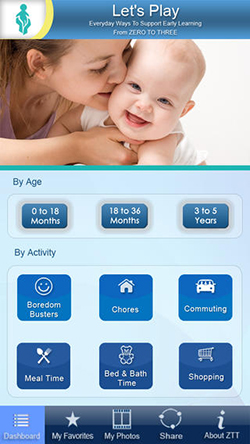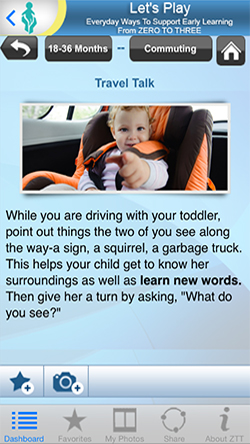The Harvard Family Research Project separated from the Harvard Graduate School of Education to become the Global Family Research Project as of January 1, 2017. It is no longer affiliated with Harvard University.

|
September 17, 2014 Q & A With Rebecca Parlakian: Learn Anytime With the Let's Play AppHarvard Family Research Project
|
FINE Newsletter, Volume VI, Issue 4
Issue Topic: Around the Clock: The Power of Anytime Learning
Voices From the Field
ZERO TO THREE’S Let’s Play App
The Let's Play app was developed by ZERO TO THREE, a national nonprofit organization focused specifically on the healthy development of babies and toddlers.This creative app provides families with fun ideas for keeping babies, toddlers, and preschoolers entertained and learning, especially during daily routines like commuting; doing chores; bedtime, bathtime, and mealtime activities; and shopping. The Let’s Play app also includes “boredom busters” that can be used any time that families are together. Families can search activities by age (0–18 months, 18–36 months, and 3–5 years), tag favorites, and share activities via social media. All of the activities reflect children’s typical skills at each age, and are designed to support development in the context of play and family routines. Click here to download the app.
| |
Tell me about yourself and the work that you do at ZERO TO THREE. |
|||
| |
I am the director of parenting resources at ZERO TO THREE, and my team and I are responsible for the development of all of our family resources. Our resources vary widely in format and include Web-based handouts and booklets, interactive websites, e-newsletters, videos, and apps. |
|||
| |
What was the inspiration for creating the Let’s Play app? | |||
| We had an opportunity to apply for a grant that was focused on supporting the ability of nonprofits to launch new smartphone applications to their respective key audiences. For quite a while, we had been talking about developing an app because we knew that smartphone use was huge among families of all socioeconomic levels. We wanted to think of a creative way of engaging families. At the same time, we had the belief that people turn to apps to solve problems. So we wondered, “What would be a problem that we could help solve via the app format?” Rather than just creating an app with static child-development milestones, we asked, “What are some of the problems facing families with young children?” and “Why would a family member want to open our app on a regular basis?” | ||||
| |
What is the research behind the Let’s Play app? How did you and your team come up with the concept? |
|||
| |
After a series of brainstorming sessions, we came up with the notion that many families of very young children are looking for new play activities, especially ones that can be used in conjunction with other daily routines—like going to the supermarket. So we then focused in on daily experiences that children share with their families, like commuting, doing chores around the house, going to the supermarket, and routines like mealtime, bedtime, and bathtime. We developed parent–child play activities that could be done within the context of these everyday moments for children aged birth to 5. Ultimately, the app is designed to help families turn daily routines into fun, play-based opportunities to learn. |
|||
| |
Were you targeting a particular socioeconomic group? | |||
| |
As always, our goal is to reach all families who are looking for support and child development information. We wanted to make sure that offering this resource via an app wouldn’t exclude any families. We did a review of the research and found that many families from low-income households are online and accessing the Internet primarily via smartphones. A study from the Pew Research Center’s Internet and American Life Project found that individuals from low-income households report owning more Android phones than iPhones.1 So, it was really important for us to offer the app on both the Android and Apple platforms to reach the maximum number of families. | |||
| |
ZERO TO THREE has a long history of offering families tools to support their children’s school readiness. How does the Let’s Play app contribute to family engagement in school readiness? | |||
| |
I think that’s a really good question. If you ask families if they want their child to succeed in school, 99.9 percent of them would say, “Yes, absolutely!” The Let’s Play app helps close the gap between that answer, “Yes,” and where the rubber meets the road. The app gives families very tangible, concrete things that they can do with their children to support early learning in fun, developmentally appropriate ways. It’s really not about direct instruction for very young children; it’s about finding those teachable moments and playful opportunities that happen every day. Families can turn an ordinary task like popping apples into a bag at the supermarket into a teachable moment by saying, “This apple is red, this one is green,” or “Let’s count the apples together...one! two! three! four! five!” We have found that once families know what to do, they are excited to share these joyful, learning moments with their child. | |||
| |
How does the app help address the time constraints of families today? | |||
| |
I think what the app does is to enhance routines like riding the bus, commuting in the car, going to the grocery store, or folding clothes in a laundry basket. It tells families, “In this moment, you are doing what we all have to do every day, but here’s an idea for how to use this moment to connect with your child and support his or her learning.” | |||
| |
Have you received any initial feedback about how practitioners are using this app to promote family engagement? | |||
| We have heard from home visiting professionals who are using it with families to show them how they can discover learning opportunities within everyday routines. The home visiting professionals find it helpful to sit down with families and talk through their everyday routines, and then provide them with specific ideas and strategies from the Let’s Play app. For example, if the home visitor knows that a family member takes the subway or bus, she reviews the ideas from the commuting section with the parents (pictured below). Home visitors tell us that they see the app as another tool in their toolbox. | ||||
|
||||
| |
What is the big takeaway you want for families who use this app? | |||
| |
I would really emphasize the importance of remembering that anytime you are with your child is an opportunity to connect, to have fun, and to engage your child in talking about and experiencing new ideas—sitting in the car and playing I Spy, for example, or walking out to get the mail and stopping to look at the ants that are marching in a line down the sidewalk. These are all opportunities; every moment with a child is an opportunity to talk and connect, and to follow the child’s lead and see what is interesting to him or her. You can use these everyday moments as jumping-off points for all kinds of learning. | |||
Rebecca Parlakian serves as director of parenting resources at ZERO TO THREE, a national nonprofit promoting the healthy development of children from birth to age 3. In that role, she provides professional development to infant-toddler professionals and program leaders, and develops resources, curricula, DVDs, and other content for parent audiences. Rebecca holds a master’s degree in education and human development, focusing on infant-toddler special education, from the George Washington University, where she is currently serving as adjunct faculty.
1 Smith, A. (2013). Smartphone ownership 2013. Retrieved from http://www.pewinternet.org/2013/06/05/smartphone-ownership-2013/
This resource is part of the September FINE Newsletter. The FINE Newsletter shares the newest and best family engagement research and resources from Harvard Family Research Project and other field leaders. To access the archives of past issues, please visit www.hfrp.org/FINENewsletter.


